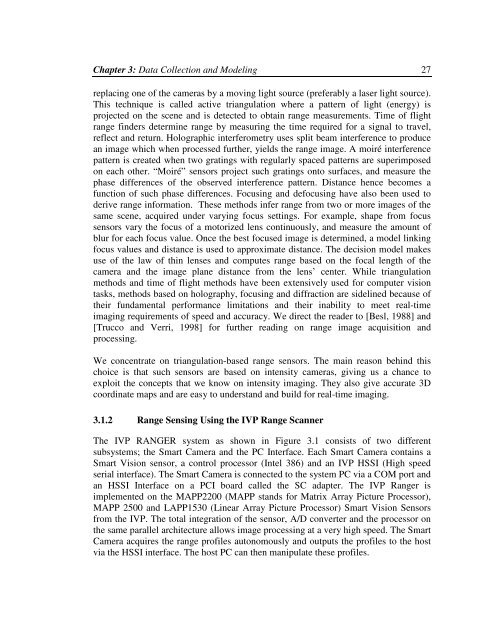To the Graduate Council: I am submitting herewith a thesis written by ...
To the Graduate Council: I am submitting herewith a thesis written by ...
To the Graduate Council: I am submitting herewith a thesis written by ...
Create successful ePaper yourself
Turn your PDF publications into a flip-book with our unique Google optimized e-Paper software.
Chapter 3: Data Collection and Modeling 27replacing one of <strong>the</strong> c<strong>am</strong>eras <strong>by</strong> a moving light source (preferably a laser light source).This technique is called active triangulation where a pattern of light (energy) isprojected on <strong>the</strong> scene and is detected to obtain range measurements. Time of flightrange finders determine range <strong>by</strong> measuring <strong>the</strong> time required for a signal to travel,reflect and return. Holographic interferometry uses split be<strong>am</strong> interference to producean image which when processed fur<strong>the</strong>r, yields <strong>the</strong> range image. A moiré interferencepattern is created when two gratings with regularly spaced patterns are superimposedon each o<strong>the</strong>r. “Moiré” sensors project such gratings onto surfaces, and measure <strong>the</strong>phase differences of <strong>the</strong> observed interference pattern. Distance hence becomes afunction of such phase differences. Focusing and defocusing have also been used toderive range information. These methods infer range from two or more images of <strong>the</strong>s<strong>am</strong>e scene, acquired under varying focus settings. For ex<strong>am</strong>ple, shape from focussensors vary <strong>the</strong> focus of a motorized lens continuously, and measure <strong>the</strong> <strong>am</strong>ount ofblur for each focus value. Once <strong>the</strong> best focused image is determined, a model linkingfocus values and distance is used to approximate distance. The decision model makesuse of <strong>the</strong> law of thin lenses and computes range based on <strong>the</strong> focal length of <strong>the</strong>c<strong>am</strong>era and <strong>the</strong> image plane distance from <strong>the</strong> lens’ center. While triangulationmethods and time of flight methods have been extensively used for computer visiontasks, methods based on holography, focusing and diffraction are sidelined because of<strong>the</strong>ir fund<strong>am</strong>ental performance limitations and <strong>the</strong>ir inability to meet real-timeimaging requirements of speed and accuracy. We direct <strong>the</strong> reader to [Besl, 1988] and[Trucco and Verri, 1998] for fur<strong>the</strong>r reading on range image acquisition andprocessing.We concentrate on triangulation-based range sensors. The main reason behind thischoice is that such sensors are based on intensity c<strong>am</strong>eras, giving us a chance toexploit <strong>the</strong> concepts that we know on intensity imaging. They also give accurate 3Dcoordinate maps and are easy to understand and build for real-time imaging.3.1.2 Range Sensing Using <strong>the</strong> IVP Range ScannerThe IVP RANGER system as shown in Figure 3.1 consists of two differentsubsystems; <strong>the</strong> Smart C<strong>am</strong>era and <strong>the</strong> PC Interface. Each Smart C<strong>am</strong>era contains aSmart Vision sensor, a control processor (Intel 386) and an IVP HSSI (High speedserial interface). The Smart C<strong>am</strong>era is connected to <strong>the</strong> system PC via a COM port andan HSSI Interface on a PCI board called <strong>the</strong> SC adapter. The IVP Ranger isimplemented on <strong>the</strong> MAPP2200 (MAPP stands for Matrix Array Picture Processor),MAPP 2500 and LAPP1530 (Linear Array Picture Processor) Smart Vision Sensorsfrom <strong>the</strong> IVP. The total integration of <strong>the</strong> sensor, A/D converter and <strong>the</strong> processor on<strong>the</strong> s<strong>am</strong>e parallel architecture allows image processing at a very high speed. The SmartC<strong>am</strong>era acquires <strong>the</strong> range profiles autonomously and outputs <strong>the</strong> profiles to <strong>the</strong> hostvia <strong>the</strong> HSSI interface. The host PC can <strong>the</strong>n manipulate <strong>the</strong>se profiles.
















